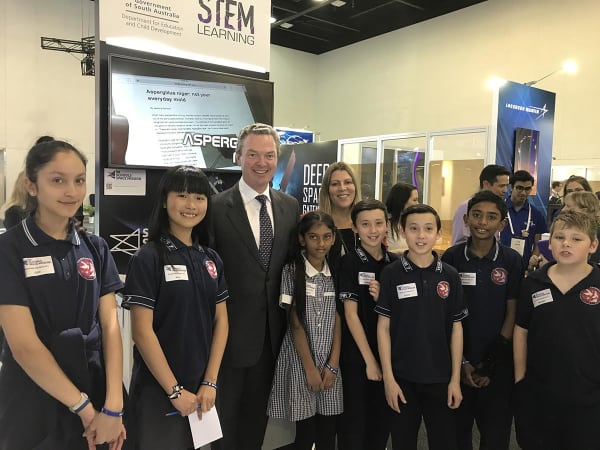Local primary school gains Saab Australia support for space research
With support from Saab Australia engineers, eager young students from Parafield Gardens R-7 are venturing into the realms of space to solve a first world problem—landfill.
 PHOTO: Students at 68th International Astronautical Congress, Adelaide
PHOTO: Students at 68th International Astronautical Congress, Adelaide

Saab Australia administration manager, Kate Swanson learnt the school needed an industry partner to help them with an entry into the South Australian Government’s ‘Schools Space Mission’ to physically launch a research project into space.
“A team of seven high-achieving maths, science and literacy student in years 5-7 decided to research a solution for the global landfill pollution problem,” said Kate Swanson. “When I heard, I thought this would be a great opportunity for our company and community to engage with the local school as an industry partner”
The idea to analyse mould came to the students after an experiment on rubbish disposal.
“The experiment made them question whether it was possible to effectively break down rubbish in a perfect environment which didn’t necessarily have to be on Earth,” said Parafield Gardens R-7 program coordinator, Melissa MacDonald.
The students visited Saab Australia last month to seek professional advice and support from a group of Saab Australia engineers who were interested to volunteer their time and knowledge.
“We had the idea but needed engineering direction, so we’re grateful Saab Australia came on board to look at their plans and help them through the engineering design process”, said Melissa MacDonald.
The engineers helped the students understand the engineering process, gave them ideas, recommendations and even a contact to a mould microbiologist at Adelaide University.
“A good number of our engineers have volunteered to help the project, often in their own time. We don’t do the work for them but we help them with the sorts of things they need to think about and how to prototype different ideas,” said Dr Derek Rogers, Head of Autonomous Vessels with Saab Australia.
With the engineers’ advice, the students redesigned their module to contain a mould sample which they hope to launch into space to sit on a platform outside the International Space Station for twelve months. With Saab’s assistance they engineered a 3D design of their module and where able to get a 3D printed prototype to present with their entry.
The team are now waiting to hear if their project is one of the six down-selected by the SA Schools Space Mission selection panel to enter the prototype and testing stage.
Entries were presented at the 68th International Astronautical Congress recently held in Adelaide. A decision for the shortlist to the next phase will be made 30 October.
When Neumann Space CEO, Ian Whitchurch saw the student's 3D module design on display at the astronautical congress, he "got very excited," said Melissa MacDonald, as their engineers' containment box designs were very similar which was quite a surprise.
Three final experiments will be launched into space and monitored by the students via high-tech sensors and receptors, with data streamed data back to the classroom. Students will record and analyse any progress over a twelve month period before the sample jettisons back and burns up re-entering the Earth’s atmosphere.
“We’re excited to be supporting the school and seeing the growth in confidence of the students as they learn about engineering a solution. We’d be delighted to see them get their experiment into space and maybe add that to our resumes”, said Dr Derek Rogers
 PHOTO: Parafield Gardens R-7 School students attracted the attention and praise from Defence Industry Minister, Hon Christopher Pyne
PHOTO: Parafield Gardens R-7 School students attracted the attention and praise from Defence Industry Minister, Hon Christopher Pyne
